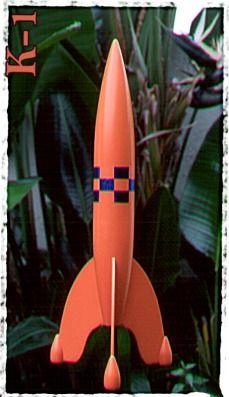| Manufacturer: | Fat Cat Rockets |

(Contributed - by David Urbanek)
Brief:
Cool rocket inspired by Russian amateur and 1950s Sci-Fi movies.
 Construction:
Construction:
One short body tube, nose cone (Estes long BT- 80) and tail cone (cut from
Estes long BT-80). Three big balsa fins and hardwood landing pods. One plywood
centering ring. Nose weight in the form of BBs. Recovery system connects
through steel cable that you have to loop and crimp. Also included is some
elastic shock cord and a 24" parachute that appears completely adequate.
Also included is some stick-on vinyl to fancy up the rocket.
The instructions are quite good. I have a lot of experience, and had no problems following along. My fiancée has less experience, and she had no problems either. The only part that wasn't well described was the insulator that protected the plastic tail cone from ejection gasses. Everything else flowed logically. Parts fit was very good. The fin slots in the tail cone were perfect and the bottom of the tail cone was just right. The only parts that didn't fit well were the hardwood landing pods on the ends of the fins. They required extensive sanding of the fins to make the pods fit. All parts are strong enough for this size rocket. I put most everything together using 5 minute epoxy. Be careful in aligning the launch lugs. Mounting them on the fin is a great idea, but you can inadvertently end up aiming the rod into the body if you're not careful. Also, finishing your fins is more difficult with the lugs in the way. The only thing I changed was to cut the bottom of the nose cone off and replace the elastic shock cord with 9 feet of woven polyprolene cord. When I added the nose weight, I put the shock cord into the nose first, and poured the BB/Epoxy mixture over it. This is a good sturdy mount. Flame protection is done using a flame proof shield rather than disposable wadding. I also left about 1/4" of the motor mount extending below the tail cone for motor retention purposes.
Finishing:
I filled all the balsa with two applications of Balsa Lite, sanding after each
application. The joint between the landing pods and the fins were filleted with
a two part epoxy putty. Then everything got a thin coat of fiberglass epoxy.
This gives the fins a very hard, very smooth finish. I didn't bother with the
spiral groove in the body tube, it's BT-80 and very subtle. A couple coats of
primer took care of this. You could fill the seam between the tail cone and
body tube with some good putty, this would further improve the appearance. I
finished it with 4 coats of Krylon White Sandable Primer and three coats of
Krylon True Blue. Warning: the contrast between the brown body tube and white
nose and tail is hard to cover. Even after four coats of primer, I could still
tell the color difference. If you use a light, slightly transparent color, you
will get subtle color differences that are readily apparent to the human eye.
Construction Rating: 4 out of 5
Flight:
The recommended motors should give you a good flight. I've made three flights
with the Aerotech E18-7 and each flight has been perfect. First, I prep the
motor. After putting the motor in the motor mount, I run a couple wraps of
masking tape round the motor end and the exposed motor mount tube. This is a
good retention system and has held just fine in all my similar rockets. Then
put the flame shield in the body tube and pack the chute and shock cord in the
nose. When I put everything together, the chute and cord fall into the body
tube, but it's easier to get the nose cone on if everything is in the nose. If
you don't cut the bottom off the nose cone, this could be a tight fit. The
rocket flies very, very straight despite its unorthodox appearance. I think one
of the main reasons is that the fin slots in the tail cone are perfectly
aligned.
Recovery:
The E18-7 ejects right at apogee, so I suspect the E15-7 will do just as well.
This rocket flies plenty high on an E, but if you want to try an F, I'd do an
F24-7, or an F32-10. You better have a really big field. The provided parachute
is the perfect size. This is nice to see in this day and age of undersized
chutes.
Flight Rating: 5 out of 5
Summary:
This is an excellent kit. Top quality components all around. Frankly, this is
the least modified kit I have. I felt confident that each and every component
was just right for the rocket and flight testing has proven me right. It's an
attention getter, on the pad, and then when it flies perfectly straight and
true, it really gets attention. I like unusual kits, and this is a good one.
The price is reasonable for what you get because you don't have to buy anything
extra to make a durable, flyable model.
Overall Rating: 5 out of 5
 |
 |